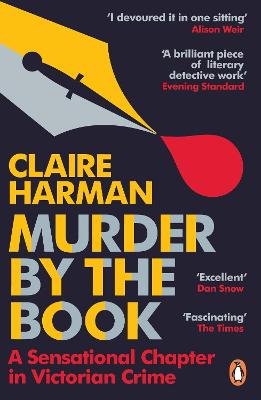
*Shortlisted for the CWA Gold Dagger for Non-Fiction 2019*
'A fascinating portrait of Victorian London' Observer
'I devoured it in one sitting' Alison Weir
'Excellent' Dan Snow
Early on the morning of 6 May 1840, on an ultra-respectable Mayfair street, the elderly Lord William Russell was discovered in bed with his throat cut so deeply that the head was almost severed.
When Lord William's assassin claimed to having been inspired by a recent sensational novel, it sent shock waves through literary London, and drew both Dickens and Thackeray into the fray. The crime, the investigation, the city's fevered fixation and the mores of the Victorian age are all brilliantly evoked and scrutinized in Claire Harman's spellbinding account of a surprisingly literary crime.
'A scandalous Victorian mystery' Guardian
'Fascinating, entertaining. Harman's tale is never less than rip-roaring' Daily Telegraph
'Vivid and punchy' Spectator
- ISBN10 0241346940
- ISBN13 9780241346945
- Publish Date 12 September 2019 (first published 25 October 2018)
- Publish Status Active
- Publish Country GB
- Imprint Penguin Books Ltd
- Format Paperback (B-Format (198x129 mm))
- Pages 224
- Language English
Reviews


llamareads
The Victorian ton was shocked by the gruesome murder of elderly Lord William Russel, found with his throat slit in his own bed in a ritzy part of London. While the mattress was soaked with blood, the rest of the room was spotless, though there were obvious signs of a robbery attempt in the rest of the house. With great pressure on the police – from even the Queen – to solve the crime in order to reassure the nervous public, it’s no surprise when the victim’s foreign valet is charged with the crime. What unfurls is an interesting exploration of literary London. It’s not that Dickens, Thackeray and the like were involved with the victim or murderer, but how the crime was formed by and then influenced the media of the time.
As the investigation into Lord William Russell’s death proceeded, several of the leading writers of the day were alarmed to find themselves suddenly under fire for having contributed to what The Monthly Review characterized as a “general want of settledness” by writing fictions that glamorized vice and made heroes of criminals. Given the chance to mould the taste of a mass audience, many of them were now accused of pandering to the lowest, with books full of violent excitements and vulgarity that could all too easily lead susceptible readers astray.
Things were already tense before the murder – the class divide was causing riots, enough to cause several sentences of drawing and quartering. The popular literature of the day turned house-breakers, thieves, and even murderers into Robin Hood-type heroes, none more so than the 18th century criminal Jack Sheppard, first romanticized by William Harrison Ainsworth and then, due to the lack of copyright laws, adapted into numerous plays that captivated not only London but the whole nation. While the masses – and the nobility – crammed into theaters to watch excellently staged (or more sensationalist) versions of the book, many simultaneously strenuously complained about the moral effect of turning criminals into celebrities. It’s strange how the more things change, the more they stay the same – we see the same thing today in the moral panic over violent video games and 4chan. From nearly his first confession, the charged valet cites Jack Sheppard as his reason for committing the murder, and despite his often contradictory statements, the public seemed to lap it up. The extent to which he enjoyed his celebrity – and the amount of newspaper inches given to promoting it – was disquieting and familiar.
Weighing in on the progress of the investigation and the kerfuffle surrounding it, we have Thackeray and Dickens (with his Oliver Twist). While the investigation, trial, and execution was the main subject of the book, I found myself more interested in the discussion of how these so-called Newgate novels came to be, and how they influenced the population in general. While this seems to be the main focus of the book, it also eventually meanders off onto several side paths, from a discussion of the death penalty to Dicken’s pet crow. While I found these forays interesting, some of them (like the pet crow who inspired Poe) felt shoehorned in to the book, and that was my biggest criticism.
During his last days in Newgate, when the prisoner issued so many different accounts of his actions, The Times gave up on trying to make sense of them: “it seems pretty clear that no credit can be given to any statement which has hitherto been made by this wretched culprit, except as regards the fact of the murder itself; but it would be idle to speculate on the motives of a mind so manifestly perverted.” But, on the contrary, a little further speculation on his motives changes the look of this crime rather dramatically.
My second criticism is that we end the book with many questions about the murder and the supposed murderer unanswered, but I find it hard to fault Ms. Harman. It’s always unsettling to see how much prejudice played into crime investigations (and how little forensic science existed – not even finger prints were understood). While the Swiss valet was undoubtedly a thief, there remains some doubt about whether he acted alone (if at all). Ms. Harman does address how the crime might have been committed (something that didn’t seem to interest the contemporary police), and, honestly with the length of time that’s passed and the lack of evidence, it seems unlikely that anyone could be expected to solve it today.
Overall, I enjoyed the book, but found it a bit meandering. If you’re a fan of Victorian true crime or interested in the early inspirations of Dickens and Thackery, I’d definitely recommend this book.
I received this book for free from First to Read in exchange for an honest review. This does not affect my opinion of the book or the content of my review.
